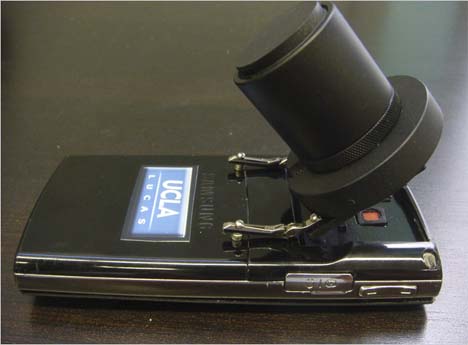 An engineer at UCLA has created a substitute for microscopes by using about $10 of off-the-shelf hardware and a mobile phone. Aydogan Ozcan has already formed a start-up, Microskia, around the new device.
An engineer at UCLA has created a substitute for microscopes by using about $10 of off-the-shelf hardware and a mobile phone. Aydogan Ozcan has already formed a start-up, Microskia, around the new device.
Ozcan imagines the devices being used for screening in the field -- locations outside of hospitals, far from technicians or diagnostic labs, he told the New York Times in a recent interview. Clearly, the device would be incredibly beneficial for many global health markets.
"In one prototype, a slide holding a finger prick of blood can be inserted over the phone’s camera sensor. The sensor detects the slide’s contents and sends the information wirelessly to a hospital or regional health center. For instance, the phones can detect the asymmetric shape of diseased blood cells or other abnormal cells, or note an increase of white blood cells, a sign of infection, he said."
That scenario makes one wonder if these devices will even find their way into the consumer health market. Here's how Miscroskia's device works:
For this electronic system of magnification, inexpensive light-emitting diodes added to the basic cellphone shine their light on a sample slide placed over the phone’s camera chip. Some of the light waves hit the cells suspended in the sample, scattering off the cells and interfering with the other light waves.
“When the waves interfere,” Dr. Brady said, “they create a pattern called a hologram.” The detector in the camera records that hologram or interference pattern as a series of pixels.
The holograms are rich in information, Dr. Ozcan said. “We can learn a lot in seconds,” he said. “We can process the information mathematically and reconstruct images like those you would see with a microscope.”
Microskia is reminiscient of the team at University of California at Berkeley's mobile phone-based microscope offering, CellScope: A conventional cell phone is transformed into a compact, high-resolution, handheld microscope with the capability of on-site disease diagnosis and wireless transmission of patient data to clinical centers for remote diagnosis & treatment. Developed by Dr. Daniel Fletcher, Dr. Erik Douglas and Dr. Wilbur Lam of the University of California at Berkeley.
Fletcher is a key advisor to the Obama Administration and has spoken about the federal government's interest in wireless health in the past.



















